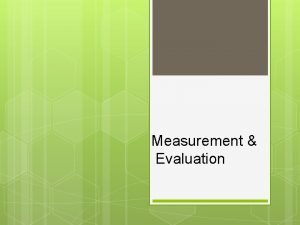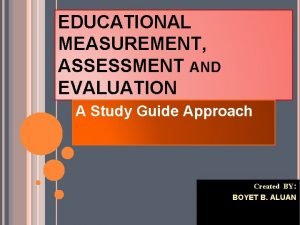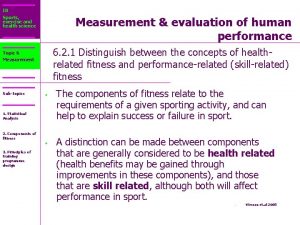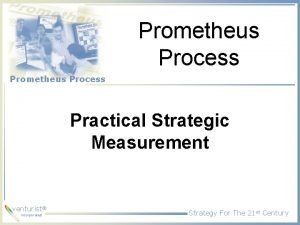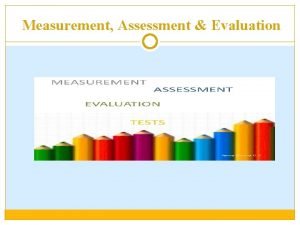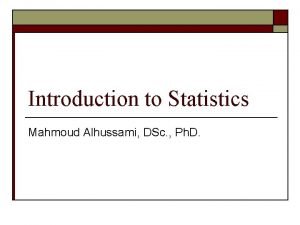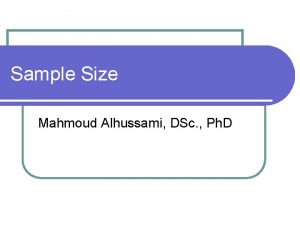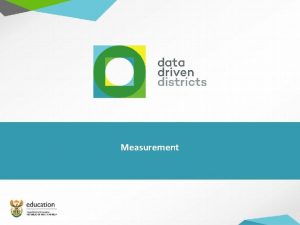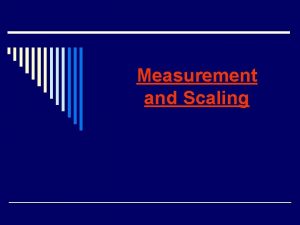Measurement and Evaluation of Health Education Mahmoud Alhussami




















- Slides: 20

Measurement and Evaluation of Health Education Mahmoud Alhussami, D. Sc. , Ph. D.

Measurement and Evaluation of Health Education • Measurement is the collection of information on which a decision is based. • The purpose of measurement is to collect information for evaluation. • Evaluation is the use of measurement in making decisions about client progress. • Formative evaluation is gathering data for the purpose of improving the teaching/learning process. • Summative evaluation is evaluation conducted at the end of an instructional unit.

Purposes of Measurement and Evaluation • Measurement and evaluation help educators to: – Assess the effectiveness of teaching methods and learning activities. – Develop the scope and sequence of teaching. – Motivate learners.

Methods of Evaluation • Newer methods used for evaluation include: – Performance-based evaluation. – Narrative grading. – Portfolios. – Group projects. – Individual Exhibits. – Critical thinking essays.

Skills Needed for Competent Measurement and Evaluation • Choosing evaluation strategies (both quantitative and qualitative). • Identifying accessing, and evaluating the most commonly used assessment instruments. • Techniques of administration and methods of scoring evaluation instruments. • Interpreting and reporting assessment results. • Using assessment results in decision making. • Interpreting and presenting statistical information about assessment results. • Conducting and interpreting program evaluations.

In constructing tests, each of the following components must be included: 1. Validity—Does the test measure what it purports to measure? 2. Reliability—Does the test measure whatever it measures consistently? 3. Objectivity—Is the test fair to all the participants? 4. Discrimination—Does the test differentiate among levels of participants ability (e. g. , excellent, good, average, and poor)? 5. Comprehensiveness—Is the test long enough to cover the material? 6. Administration and Scoring—Is the test easy to give, use, and score?

Developing a test involves the following steps: 1. Prepare the table of specifications based on the unit objectives. 2. Draft the test items. 3. Decide on the length of the test. 4. Select and edit the final items. 5. Rate the items in terms of difficulty. 6. Arrange the items in order of difficulty from easiest to most difficult. 7. Prepare the instructions for the test. 8. Prepare the answer key and decide the rules for scoring. 9. Produce the test.

Developing Tests: Specifications for Unit on Substance Abuse

Developing Tests • Paper-and-pencil tests are effective for measuring participant progress in the cognitive domain. • Several types of items can be used for testing purposes. • All similar items should be grouped together. For example, group true/false items together, and group multiple-choice items together. • Test items should proceed from simple to complex (e. g. , true/false, matching, multiple choice, short answer questions, essay questions).

Writing Effective Test Items • True/False Tests— Participants must decide whether each test item is true or false and answer accordingly. • Matching Tests—Participants must pair the answer given in one column with a corresponding item in another column. • Multiple-Choice Tests—Participants must recognize which of several suggested responses is the best answer. • Short Answer Tests (Completion Tests)—Participants must be able to fill-in-the-blanks or list items to answer the question or statement. • Essay Question Tests—Participants must be able to organize information in a systematic fashion.

Measuring Health Attitudes • One of the goals in health education is to develop positive health attitudes. • Attitudes are frequently measured in health education/promotion programs because attitudes are key to behavior change. • It is difficult to evaluate attitudes, and many tests designed for this purpose lack validity. • Attitude formation is a gradual process; instant behavioral changes are not likely to occur.

Common Written Measures • Attitude Scales. (e. g. , forced-choice scale and Likert scale( • Observation. • Checklists.

Example of a Forced-Choice Attitude Scale

A Likert Scale with a Five-Choice Spread

Observation Checklist for Assessing Respect for Others

Traditional Grading Strategies • Percentage Method • A to F Combination Method • Pass/Fail Method

Contemporary Grading Strategies • Performance-Based Evaluation—is based on the student’s ability to show what they have learned, rather than what they are able to recall. – Portfolios – Exhibitions – Critical thinking essays – Group Work

Performance-Based Evaluation • Exhibitions—are considered a performance test or demonstration of learning that is presented before an audience and takes extended time to prepare (e. g. displays, skits, plays, bulletin boards). • Critical Thinking Essays—Involves a writing activity that allows the student to analyze or synthesize information in order to make a decision.

Contemporary Grading Strategies • Peer Evaluation – Students work together to evaluate each others’ work • Narrative Grading – Dialogue between the student and teacher about the work. – Dialogue should be student generated and reflect creative options and critical thinking.

 Measurement and evaluation for health educators
Measurement and evaluation for health educators Progress and performance measurement and evaluation
Progress and performance measurement and evaluation Evaluation in progress
Evaluation in progress Different between health education and health promotion
Different between health education and health promotion Concept map of measurement assessment and evaluation
Concept map of measurement assessment and evaluation Kcapanse
Kcapanse Measurement and evaluation in human performance 5e download
Measurement and evaluation in human performance 5e download Measurement and evaluation in human performance
Measurement and evaluation in human performance Strategic measurement and evaluation
Strategic measurement and evaluation Definition of measurement in education
Definition of measurement in education Health propaganda definition
Health propaganda definition Mahmoud abdelfattah age
Mahmoud abdelfattah age Tytu meaning
Tytu meaning Dr mahmoud salman
Dr mahmoud salman Mahmoud arafa
Mahmoud arafa Boudarene mahmoud
Boudarene mahmoud Mahmoud sarmini md
Mahmoud sarmini md Adp antagonist drugs
Adp antagonist drugs Mahmoud khattab md
Mahmoud khattab md Hana mahmoud
Hana mahmoud Internal and external evaluation
Internal and external evaluation




